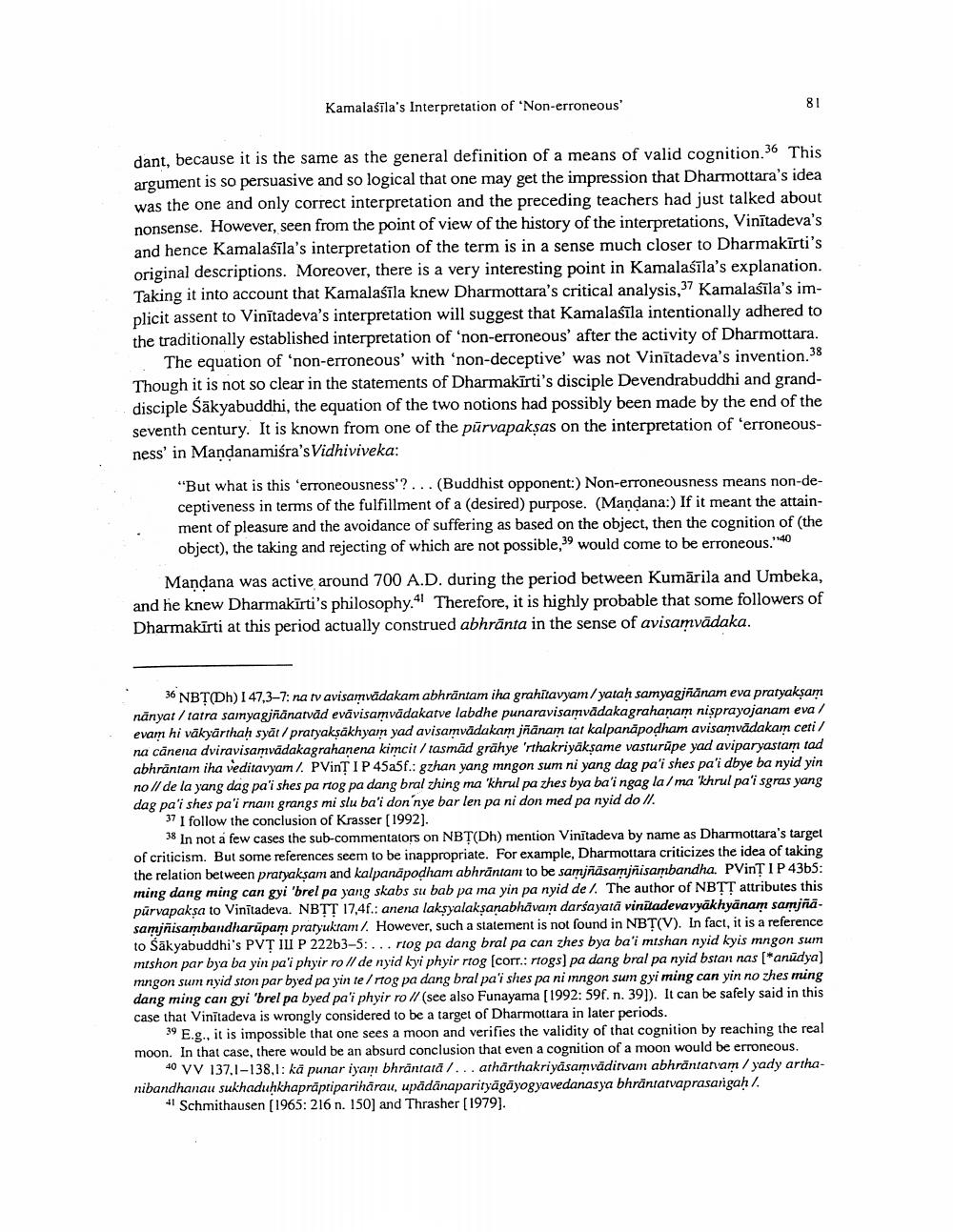________________
Kamalaśīla's Interpretation of 'Non-erroneous'
dant, because it is the same as the general definition of a means of valid cognition.36 This argument is so persuasive and so logical that one may get the impression that Dharmottara's idea was the one and only correct interpretation and the preceding teachers had just talked about nonsense. However, seen from the point of view of the history of the interpretations, Vinītadeva's and hence Kamalaśīla's interpretation of the term is in a sense much closer to Dharmakīrti's original descriptions. Moreover, there is a very interesting point in Kamalaśīla's explanation. Taking it into account that Kamalasīla knew Dharmottara's critical analysis, 37 Kamalaśīla's implicit assent to Vinītadeva's interpretation will suggest that Kamalaśīla intentionally adhered to the traditionally established interpretation of 'non-erroneous' after the activity of Dharmottara.
The equation of 'non-erroneous' with ‘non-deceptive' was not Vinītadeva's invention.38 Though it is not so clear in the statements of Dharmakīrti's disciple Devendrabuddhi and granddisciple Sākyabuddhi, the equation of the two notions had possibly been made by the end of the seventh century. It is known from one of the pūrvapakşas on the interpretation of 'erroneousness' in Mandanamiśra's Vidhiviveka:
"But what is this erroneousness'?... (Buddhist opponent:) Non-erroneousness means non-deceptiveness in terms of the fulfillment of a (desired) purpose. (Mandana:) If it meant the attainment of pleasure and the avoidance of suffering as based on the object, then the cognition of the object), the taking and rejecting of which are not possible, would come to be erroneous.40
Mandana was active around 700 A.D. during the period between Kumārila and Umbeka, and he knew Dharmakīrti's philosophy. Therefore, it is highly probable that some followers of Dharmakīrti at this period actually construed abhränta in the sense of avisamvädaka.
36 NBT(Dh) I 47,3–7: na tv avisamvadakam abhrāntam iha grahitavyam/yatah samyagjñānam eva pratyakşam nänyat / tatra samyagjñānatväd evāvisamvadakatve labdhe punaravisamvadakagrahanam nisprayojanam eva/ evam hi vākyārthah syāt / pratyakşakhyan yad avisamvādakam jñanam tat kalpanapodham avisamvādakam ceti/ na canena dviravisamvādakagrahanena kimcit / tasmad grāhye 'rthakriyaksame vasturūpe yad aviparyastam tad abhrāntam iha veditavyam/. PVinȚI P 45a5f.: gzhan yang mngon sum ni yang dag pa'i shes pa'i dbye ba nyid yin no Il de la yang dag pa'i shes partog pa dang bral zhing ma 'khrul pa zhes bya ba'i ngag la/ma 'khrul pa'i sgras yang dag pa'i shes pa'i rnam grangs mi slu ba'i don'nye bar len pa ni don med pa nyid do Il.
37 I follow the conclusion of Krasser (1992).
38 In not a few cases the sub-commentators on NBT(Dh) mention Vinītadeva by name as Dharmottara's target of criticism. But some references seem to be inappropriate. For example, Dharmottara criticizes the idea of taking the relation between pratyakşam and kalpanapodham abhrāntam to be samjñāsamjñisambandha. PVins IP 4365: ming dang ming can gyi 'brel pa yang skabs su bab pa ma yin pa nyid de /. The author of NBTT attributes this purvapaksa to Vinītadeva. NBTT 17.4f.: anena laksyalaksanabhavam darśayatā vinūtadevavyākhyānam samjña. samjñisambandharūpam pratyukram/. However, such a statement is not found in NBȚ(V). In fact, it is a reference to Sākyabuddhi's PVT III P 222b3-5:... rlog pa dang bral pa can zhes bya ba'i mtshan nyid kyis mngon sum mtshon par bya ba yin pa'i phyir ro II de nyid kyi phyir rtog (corr.: rtogs) pa dang bral pa nyid bstan nas *anūdya) mngon sum nyid ston par byed pa yin te / rog pa dang bral pa'i shes pa ni mngon sum gyi ming can yin no zhes ming dang ming can gyi 'brel pa byed pa'i phyir ro II (see also Funayama (1992: 59f. n. 39]). It can be safely said in this case that Vinītadeva is wrongly considered to be a target of Dharmottara in later periods.
39 E.g., it is impossible that one sees a moon and verifies the validity of that cognition by reaching the real moon. In that case, there would be an absurd conclusion that even a cognition of a moon would be erroneous.
40 VV 137,1-138,1: kā punar iyam bhrāntatā /... atharthakriyasamvāditvam abhrānta vam/yady arthanibandhanau sukhaduhkhaprāptipariharau, upädänaparityāgāyogyavedanasya bhräntarvaprasangahl.
41 Schmithausen (1965: 216 n. 150) and Thrasher (1979).




